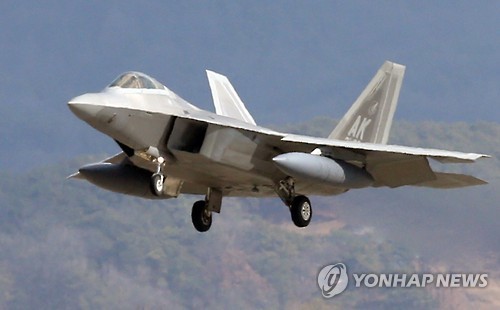US to send strategic assets to military drill with S. Korea
By KH디지털2Published : Feb. 14, 2017 - 10:46
The United States will send its strategic assets to a joint military exercise with South Korea next month as North Korea has escalated tensions with its latest missile launch, military officials said Tuesday.
"The two sides have agreed to send such weapons as the F-22 stealth fighter and a nuclear-powered submarine to the Key Resolve and Foal Eagle exercises in March," a defense official familiar with the matter told Yonhap News Agency.
"The two sides have agreed to send such weapons as the F-22 stealth fighter and a nuclear-powered submarine to the Key Resolve and Foal Eagle exercises in March," a defense official familiar with the matter told Yonhap News Agency.

Other assets expected to join the annual drill include the USS Carl Vinson aircraft carrier, as well as the B-1B and B-52 bombers.
The Carl Vinson made a port call in Guam on Friday in what could be a preparation to join the drill.
In a report to lawmakers, the Ministry of National Defense said Tuesday, "We are in talks with the U.S. to determine the size of US strategic assets to be deployed and the range of their exposure to local media."
The move is to show the allies' full readiness and combat capabilities against the North's nuclear and other weapons of mass destruction, the ministry said. It said this year's drills, which run through April, will be the "biggest-ever" joint exercise to date.
The ministry said it will establish a multilayered missile defense system that consists of the Korea Massive Punishment & Retaliation plan, surveillance satellite project and mass production of mid-range surface-to-air missiles.
The KMPR directly targets the North's military leadership with the aim of neutralizing key figures and infrastructure if there are clear signs of the imminent use of nuclear weapons.
The KMPR is part of the three-pillar system being sought by the military by the mid-2020s to enhance the country's defense capabilities. Two others are a "kill chain" strike system and the Korean Air and Missile Defense, both designed to detect and destroy incoming missiles in the shortest possible time.
"We are planning to set up the establishment of the three-pillar system (in several years) and are in talks with the budget department to acquire strategic military assets as early as possible due to ever-growing threats from North Korea," a defense ministry official said.
Still, the North's latest test-firing of a new intermediate-range missile using a solid-fuel motor sparked worries that the kill chain and KAMD systems may fail to deal with growing threats from North Korea. Solid-propellant missile pose a greater threat as they require less preparation time than liquid-fueled rockets, and can be fired more easily from a mobile launcher.
In a meeting with lawmakers in charge of defense matters, Defense Minister Han Min-koo tried to ease the concerns, saying "We cannot conclude that the kill chain is not an effective anti-missile defense system any longer as the North began to adopt a solid-fuel engine (for an intermediate-range missile) instead of a liquid-fuel one."
In other counter moves to deal with the North, the Defense Acquisition Program Administration said Tuesday it will spend about 130 billion won ($114 million) to develop an electromagnetic pulse that disrupts the North's command communication systems if detonated in the air above Pyongyang and laser weapons systems that can be employed to make a "surgical strike" on the North's nuclear and missile facilities.
Meanwhile, Seoul and Washington plan to carry out a combined live-fire exercise to deliver a message to Pyongyang that its military attacks will be met with retaliatory counterattacks by the allies, the ministry said.
Armaments likely to be mobilized in the massive live-fire drill include the K-9 self-propelled howitzers, AH-64E Apache heavy attack helicopters, 230 mm multiple launch rocket systems and the A-10 Thunderbolt aircraft, it said.
The allies have held the combined live-fire drill eight times up to August 2015 after the first in June 1977.
The North test-fired a newly developed intermediate-range ballistic missile Sunday morning in its first provocation since the inauguration of US President Donald Trump.
The launch came after North Korean leader Kim Jong-un last month threatened to test-fire an intercontinental ballistic missile capable of reaching the US mainland. (Yonhap)





![[Herald Interview] 'Amid aging population, Korea to invite more young professionals from overseas'](http://res.heraldm.com/phpwas/restmb_idxmake.php?idx=644&simg=/content/image/2024/04/24/20240424050844_0.jpg&u=20240424200058)











![[KH Explains] Korean shipbuilding stocks rally: Real growth or bubble?](http://res.heraldm.com/phpwas/restmb_idxmake.php?idx=652&simg=/content/image/2024/04/25/20240425050656_0.jpg&u=)

